Dzogchen Ponlop Rinpoche:
A Decade of Teaching With Seattle as Home
Written by: Steve Wilhelm
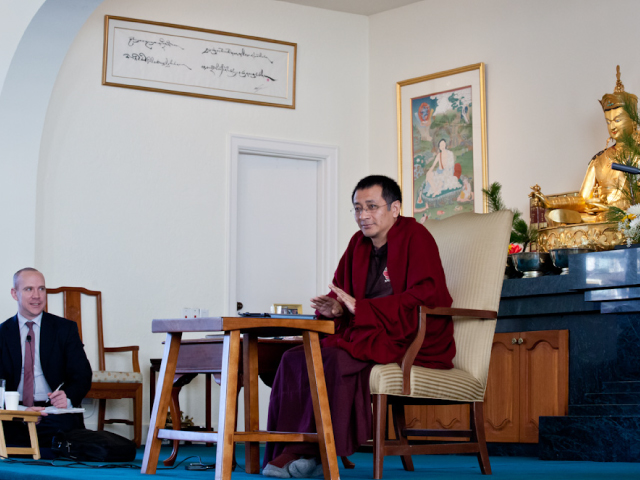
Dzogchen Ponlop Rinpoche teaching students at Nalanda West, Mitra Dean Tyler Dewar translating.
Photos by: Joshua Erickson, Rysiek Frąckiewicz, Christine Hwang, Nalandabodhi, Scott Ponwall, Steve Wilhelm.
Ten years ago Dzogchen Ponlop Rinpoche made Seattle the home of his dharma activities around the world, and created what has become Nalanda West.
Born in India, Rinpoche studied with some of the great teachers in the Nyingma/Kagu lineage, including Dilgo Khyentse Rinpoche and his current teacher, Khenpo Tsultrim Gyamtso Rinpoche. In the last decade Nalandabodhi has grown into a substantial dharma center with a wide range of teachings and activities. The center also has been very supportive of other Buddhist and sometimes non-Buddhist traditions, and serves as a locale for many teachings and events.
In honor of Nalanda’s 10th anniversary, Dzogchen Ponlop Rinpoche consented to an interview with Northwest Dharma News. Here is some of what he had to say:
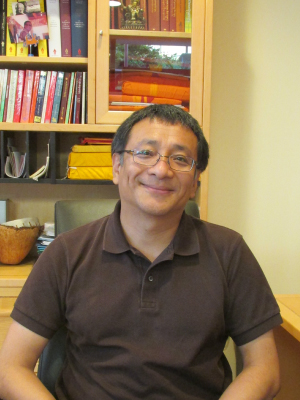
Rinpoche in his office in Seattle, after the interview.
How do you feel about the evolution of Nalanda West?
“It’s been a great blessing for us to have this opportunity, to have established a center here, Nalanda West, which we’ve been working on to make this a center for American Buddhism. I feel very happy with all the genuine enthusiasm and support from the Northwest dharma community, as well as all the same from around the word. It’s been 10 wonderful years of hardworking experience.”
What are the parallels between Nalanda here, and the famous Nalanda University in India, a crossroads of the world of Buddhism through the 12th century?
“It’s based on the original place. At Nalanda they taught 10 sciences, five major and five minor. We’re trying to do that as much as we can. Some of it being inner science of Buddhism, but also science of healing and communications. ..that’s what we are trying to encourage, and we are trying to model this facility to serve the community on the basis of that training there. We all are students of the Buddha, and we all must come together and learn together from each other. There is a lot of learn from each other.”
Why did you decide to establish Nalandabodhi in Seattle?
“I was living in Vancouver, B.C. and working in Boulder, Colorado, teaching in Naropa for many years, and I’d been passing through Seattle a lot, and my teacher Khenpo Tsultrim Gyamtso Rinpoche told me to move here. Also I came here because a lot of my students moved here from different parts of the country.”
Your Fremont headquarters is quite large. How was that for a relatively young group to step up to this, and what does it now mean?
“This was a big move for us to move to Nalanda in Fremont. It was much bigger than we had expected, and we didn’t have any funding. Since Rinpoche said this was the place, we tried our best to pursue it.
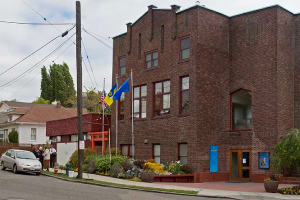
Nalanda West in Seattle.
In here we have had a lot of wonderful development, a small shrine room, then a bigger shrine room upstairs that can host 160 to 170, a dining area that can be multipurpose. We have been slowly slowly developing the facility here, it’s been slow because of limited resources. We hope to develop this as a better facility for our dharma activity, and as a center for American Buddhists. We’re open to developing it more in the future, to have a better library facility, more classrooms.”
One of your characteristics is a strong understanding of Westerners. How did this develop?
“I first came to this country when I was 14 with the 16th Karmapa, who brought me here as attendant, and who stayed for eight months. I went back with his holiness and continued monastic training.
After I finished, I came back in early ‘90s and went to Columbia University for a while. Most of my family lives in New York. My guru Khenpo Rinpoche encouraged me to teach in this country and in the West, and I’ve followed his instructions.
From a very young age, I had quite a strong connection with Western culture, and I was interested in learning more. It’s been a wonderful experience for me to be here.”
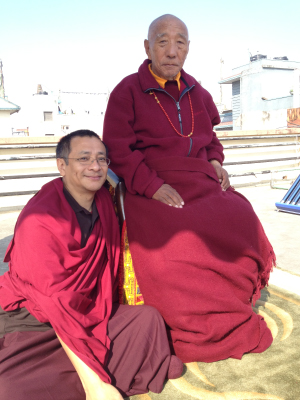
Dzogchen Ponlop Rinpoche with his teacher, Khenpo Tsultrim Gyamtso Rinpoche, in Kathmandu, March, 2012.
How has the Western approach to learning influenced your presentation of the Buddhadharma?
“I’ve learned a lot…we have a lot of similarities between Western academia and Eastern academia. At the same time there are big differences in terms of methodology and the approaches that we take.
In our training in the East, teaching is mostly focused on an objective point of view, but here it is more subjective — how I feel and think — so there is a lot more subjective flavor here.
Like for example the middle-way analysis of the Buddha’s teaching goes straight into analyzing atoms. It talks about objects, and goes directly to that kind of subject matter, and then analyzes that and talks about emptiness.
But here (in the West) there’s more about analyzing my feelings and my own mind and my body, so a little bit different approach here.”
What particular techniques have you evolved to meet the needs of Western students?
“We’ve been working very hard to have an organized, progressive path of study and mediation. This has been one of the best achievements of this sangha.
We have a progressive study path, we have developed materials, we have developed classes, we have progressive meditation training and mindful activity, that has been a big change. I don’t know about other Buddhist schools here, but among our own Buddhist schools I don’t see that this often. We have copied the Western pedagogy of training as much as we can. We also have some classes online, and we have adapted to the internet and to computers.”
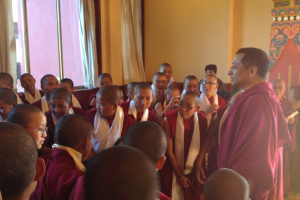
Rinpoche with anis at Tek Chok Ling Nunnery, Kathmandu, Nepal.
What does dharma mean to you, here in the 21st Century?
“For me it’s like a genuine science of mind. I really feel very intrigued and interested in exploring my own mind, my own thought and emotions, and what’s really there behind all this. Is there something more profound, and how do I handle on a day-to-day basis, habitual thoughts and habitual emotions?
Dharma for me is a living entity, that not only helps me to entertain some spiritual thought of awakening or enlightenment, but also something that is very present in my day-to-day experience of my mind. Personally I feel dharma has a lot to contribute to our world, in this world of suffering, pain and chaos, with all these negative things going on…so we can have a loving, caring, responsible, and more genuine kind of community.”
How do you see the many Buddhist lineages evolving and connecting in the West?
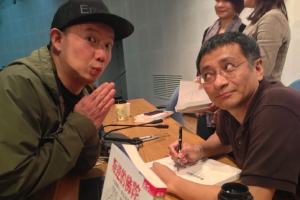
Rinpoche signs one of his books in Taipei, Taiwan.
“We all must maintain our own lineages, pure lineage teachings from all Buddhist traditions. In Theravada, Zen, Tibetan, we all can maintain our own integrity and genuineness, and follow our traditions.
Yet at the same time, there has to be some kind of merging that must take place. We are all Buddhist practitioners at the end, we all study and practice Buddhist teachings…we must come together, especially in this country. We must resolve all these issues and go beyond territorial mentality and habitual clinging in that way.
My idea is that at some point all those yanas and traditions of the Buddha’s teachings will merge into one melting pot in America. It’s already happening, with Theravada teachers getting pointing-out instructions, and Vajrayana Buddhists using Satipatthana and mindful activity. In a way it’s already merging.
And at some point it may emerge as a genuine Buddhist tradition, which does not lose any integrity and guiding principles of the lineages.”
What are the possibilities, and challenges, for people from a Western educational background trying to understand the dharma?
“My experience of the past 20-some years here, in many ways there is a genuinely higher-quality education in the West. Across the board, everyone is well educated, it’s different from our culture in the East. So therefore there is a much-better chance in terms of learning dharma, and progressing in intellectual study of dharma.
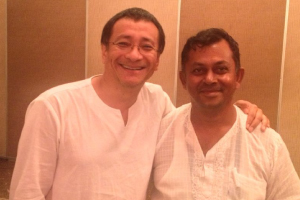
Rinpoche with Lal de Zoysa, the tour guide students hired while on pilgrimage in Sri Lanka.
At the same time, there also are different types of obstacles….there’s an intellectual obstacle, so much thinking, too much conceptualizing, and too many projections. I feel we face a different challenge in that way…the obstacles in each country and each culture very unique.
I think there is a very great opportunity to get awakened here in our Western culture and training, at the same time there are all these obstacles we have to encounter and transform.
One of the things we experience here is sometimes we have a lack of patience. It is one of our big problems here. We are in a culture of instant gratification, everything is instant. We expect the same thing with spirituality, we want instant gratification, instant awakening. Sometime it doesn’t work that way. It takes a little time, a little effort, more practice, a little more sitting, a little more processing.”
What do you think about the use of the term “Hinayana,” by people in the Mahayana traditions, to refer to Southeast Asian Buddhists?
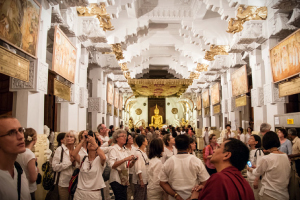
Rinpoche and students at the Temple of the Tooth, Sri Lanka.
(Editor’s note: Hinayana translates as “lesser vehicle, while Mahayana translates as “greater vehicle.” Rather than use the term Hinayana, Buddhist practitioners in Southeast Asia refer to their tradition as Theravada, which means “Teaching of the elders”.)
“Many times the interpretation of the word becomes a very negative thing. I think there needs to be some kind of adjustment there. These are so many literatures from the past, it would be impossible to change the whole thing. We have to accept such literature exists, but what we want to use now is a different story. We have a full choice of what we want to do.”
And in a related area, what is your attitude toward the sense of hierarchy, claims that some schools are superior, among various Buddhist lineages?
“It’s not like that. Absolutely not. In some sense there’s contradiction there. We say Buddha taught 84,000 dharmas, and every one of these teachings is valid, and beneficial. But if on the other hand you say there’s a hierarchy, it kind of contradicts that.”
What do you think about Northwest Dharma Association’s mission of bringing Buddhist groups closer together?
”I genuinely appreciate the effort of bringing all of us together, and the kindness of groups that can bring awareness of each other. It’s great for everyone to work together here. I hope in the future, the Northwest Dharma community can have stronger ties with each other.
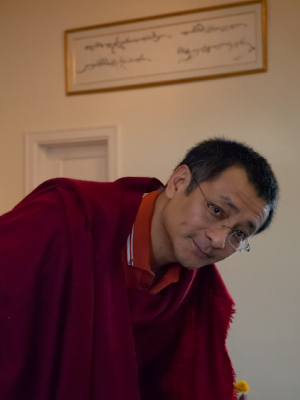
Dzogchen Ponlop Rinpoche.
I hope that all the Buddhist groups in the America, starting with Northwest Dharma community, can celebrate one day together as a Buddhist holiday. Every religious group has one holiday, but we don’t have that. If we can have one day that is Vesak day…It can be the United Nations’ Vesak day. As a Tibetan, I don’t say it has to be the Tibetan day, let’s celebrate that day together, it doesn’t matter what we choose…If we can celebrate that day, that would be excellent.
I love that, there being one day together. The other thing is, I hope we can come together around another cause, which is helping sentient beings, especially where they’re struggling, where there are unfavorable conditions with natural calamities, a way the Buddhist community can come together with one effort…If all Northwest dharma people can come together and help.”
What’s your vision for the future?
“I think we have accomplished a lot in these 10 years. We have a lot of new members of communities using our facilities, and enjoying our classes and meditation instruction. We are extremely happy with that. I’m hoping in the future we can serve better our community here, and work together for the cause of establishing a genuine Western Buddhism or American Buddhism together, with the Theravada, Zen and Vajrayana traditions.”
